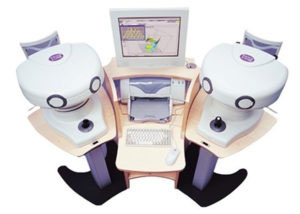
Topography

The topography of the cornea is a special examination, where through a series of colored maps (Axial Map, Tangential Map, Elevation Map, Refractive Map, etc.) the ophthalmologist obtains data concerning both quantitative and qualitative characteristics of the curvature of the cornea.
What topography is
Corneal topography is non-invasive, with which maps of the corneal surface are obtained where the coloring of the map is proportional to the degree of curvature of the corneal surface The cornea, under normal conditions, is responsible for 75% of the refractive power of the eye. Its shape is not perfectly circular, but slightly ellipsoidal. Practically, there is no person whose cornea follows the exact proportions, resulting in the appearance of the various forms of astigmatism, more or less severe.
What is achieved
With the topography of the cornea, the distribution of the refractive power of the cornea, at every point of its surface, is illustrated with colors. Where the refractive power is increased (ie there is increased curvature), the topographic map is deep red to orange, while the more flat areas are greenish to blue. In this way, the specialist can detect any serious abnormalities of the corneal surface, plan very fine operations and monitor the progress.
Procedure
The examination is done separately for each eye. The examinee looks towards a domed frame, in which illuminated concentric rings appear. The topography of the cornea becomes apparent from the shape that the reflected pattern takes. The whole system is controlled by an electronic computer, which analyzes it and renders the corresponding color, thus forming the topographical map of the cornea.
